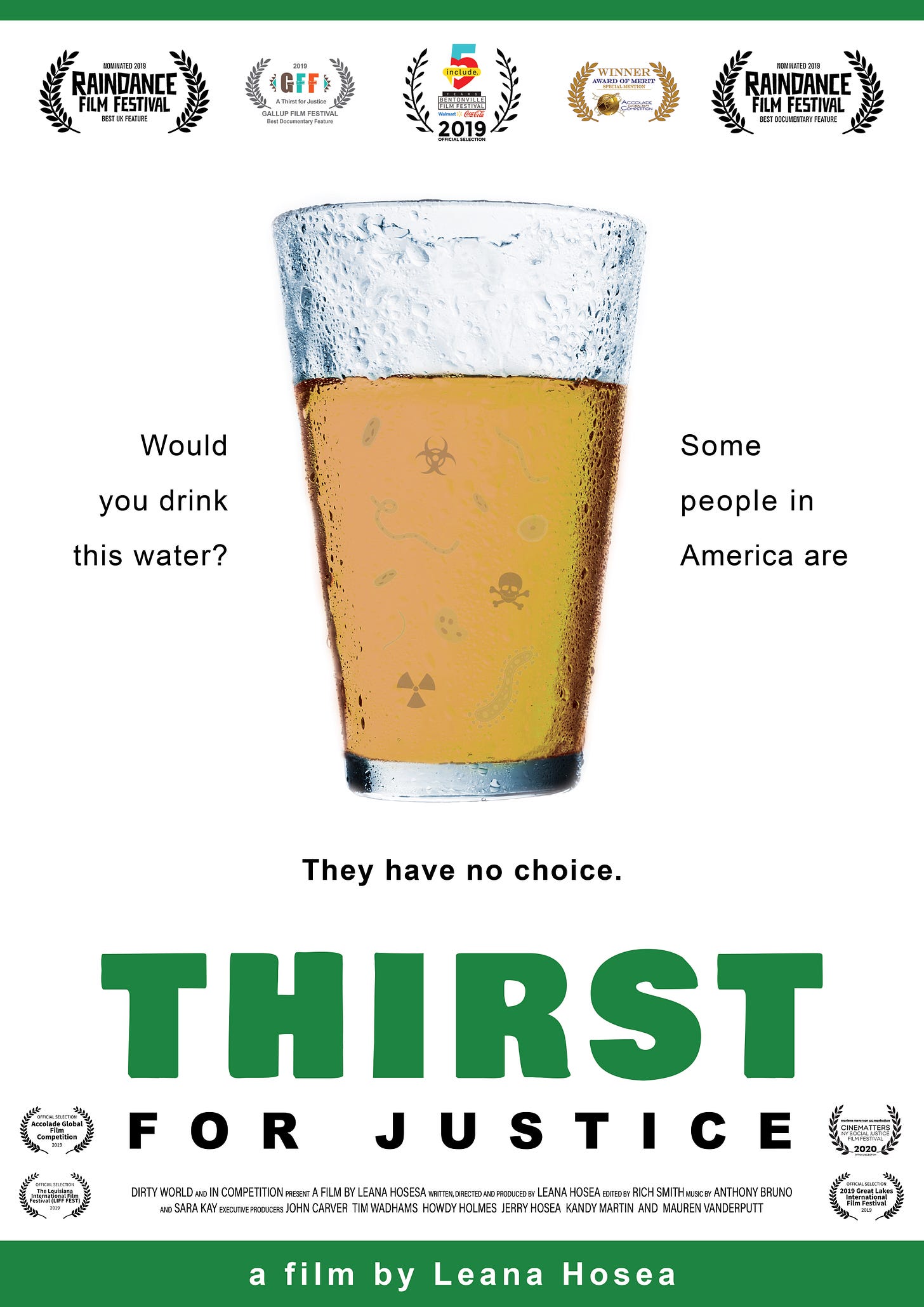Thirst For Justice
A New Film by Investigative Journalist Leana Hosea
I want to introduce you to Leana Hosea, a filmmaker and investigative journalist, who has worked for the BBC as a multi-media journalist in international news and current affairs for more than 12 years. She secured a prestigious Knight Wallace Fellowship for journalists at the University of Michigan, and then went on to make her first independent feature documentary, Thirst For Justice, on water rights in America.
She’s the writer, director, and producer of this new film. Talk about a one-woman show!
A quick synopsis of the film: You might think America is a democracy, where freedom of speech and basic rights are guaranteed. But at its heart, there is a great injustice. Against all the odds several extraordinary citizens are banding together and fighting back for their basic right to clean water. Armed only with facts and their illnesses, they risk arrest to take on the might of industry and government. From Flint to the Navajo Nation, via Standing Rock, this is their story.
I chatted with Leana via Zoom earlier today about making this movie.
Q: Tell me how you became interested in making a movie about water issues.
A: I’ve been a BBC journalist for almost 13 years and covered a lot of incredible stories, breaking news in Cairo reporting on The Arab Spring from day one in Tahrir Square, the war in Gaza, and the crisis in Yemen. But when I went to the Navajo Nation in 2010 on a BBC news assignment to look at the proposed resurgence of uranium mining in the Grand Canyon area, I was really shocked about what I saw. There are whole communities living amidst piles of radioactive uranium mine waste, drinking contaminated water. I really felt that my short news piece wasn’t going to do the story justice.
Eventually, I came back home and had many other assignments when I lived in the Middle East for a few years for the BBC. I always had this story in my mind. So I applied for some fellowships, which allowed me to make the documentary and to really investigate this problem.
These fellowships also gave me fantastic resources. I was able to borrow my nuclear engineering professor’s professional Geiger counter and she gave me some training.
I went out on the reservation and maxed out the Gieger counter, we found so many hot spots. According to my professor Kim Kearfott, she said that I found readings on the Navajo reservation that have uranium contamination levels higher than permanent evacuation zones around Chernobyl.
Q: You also feature community members from Flint, what was the connection there?
A: I had heard about Flint, as we all have. I was curious to find any links between what was happening in the two places. Obviously, there are differences as it’s a different contaminant in both areas. In Flint, it’s lead from the pipes when the water wasn’t treated properly. But I wanted to see if there was something systemic going on.
The similarities are actually quite numerous. The movie follows residents from two towns at about the same time in Flint and the Navajo town of Sanders. They both enlisted the help of independent scientists to prove suspicions that their water was dangerously contaminated.
In Flint, that was Marc Edwards of Virginia Tech and in Sanders it was a Ph.D. student, Tommy Rock. [Editors note: Navajo lands were mined heavily for uranium from 1944 to 1986, leaving more than 500 abandoned uranium mine sites and elevated levels of radiation in homes and drinking water sources. Read more about Tommy’s fantastic work here.]
They both discovered that the authorities had known all along and were covering up these water contaminations.
There’s the infamous EPA email going around Flint: Is this community worth going out on a limb for?
I followed both of my female protagonists, as they worked to lead their communities, lobby politicians, and confront the polluters.
The two women she features in the film are:
Janene Yazzie, a mother of two in Sanders, Arizona, finds out from tests carried out by a PhD student, that the drinking water in her son’s school, once her own school, has more than double the acceptable levels of uranium.
African American organizer, Nayyirah Shariff, was running a campaign against water shutoffs in Flint, when the water crisis hit. She is a pivotal leader in pushing for all the city’s lead pipes replaced and holding those guilty to account.
Through the stories of the Navajo, Flint and Standing Rock, this film links widespread water contamination to the erosion of democracy in the United States. It shows that several toxins are known to cause harm by the offending corporations and government officials, but they don’t easily share these facts.
These stories are close to my heart for so many reasons. I always like to say, “water isn’t a sound bite, it’s a story,” so we need more great storytellers to help others learn about these injustices.
I met with Navajo Nation leaders and farmers in 2015 after the Gold King Mine spill, which was triggered by an EPA crew. And I still get emails about the uranium problems there. I recently spoke with artist and activist Emma Robbins, who directs the Navajo Water Project at Dig Deep Water, about the issues of uranium poisoning and lack of running water plaguing many reservations. Check out that podcast here.
‘Thirst For Justice’ premieres March 6 on Bloomberg Quicktake Streaming TV. You can watch it for free here: https://www.bloomberg.com/qt/live




PLEASE KEEP CARING & SHARING & then....